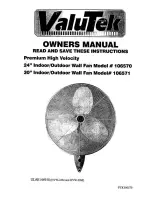
2
FAN COIL DESCRIPTION
AND TROUBLESHOOTING
ELECTRICAL OPERATION HAZARD
Failure to follow this warning could result in personal injury
or death.
Before installation or servicing system, always turn off main
power to system. There may be more than one disconnect
switch. Turn off accessory heater power if applicable. Lock out
and tag switch with a suitable warning label.
!
WARNING
MULTI
−
SPEED ECM FAN MOTOR
The multi
−
speed ECM motor used with this product contains two
parts: the control module and the motor winding section.
A.
It is normal for the motor to rock back and forth on startup. Do
not replace the motor if this is the only problem identified.
B.
If the motor is not running:
1. Check for proper high voltage and ground at the L,G, and N
connections at the motor. Correct any voltage issue before
proceeding to the next step.
2. The motor is communicated through 24
−
Vac signals to the
1, 2, 3, 4, 5 and C (common) terminals. Verify the part
number of the motor matches the correct replacement motor
part number for the unit model number.
3. Initiate a demand from the thermostat and check the voltage
between C (common) and terminal 1
−
5. If voltage is
present and the motor isn’t operating, then the motor/control
module is failed.
Fan Speed Selection
The fan speed selection is done at the motor connector. Units with
or without electric heaters require a minimum CFM. Refer to the
unit wiring label to ensure that the fan speed selected is not lower
than the minimum fan speed indicated.
Table 1 – FMC4Z & FMU4Z ECM Motor Speed Taps
Tap
Delay
−
off
Time(s)
18
24
30
36
Tap 1
90
Default
Tap 2
90
Default
Tap 3
90
Default
Tap 4
90
Default
Tap 5
90
FAN MOTOR
The motor is three
−
speed direct drive. High
−
speed lead is black,
medium
−
speed lead is red, low
−
speed lead is blue, and common
lead is purple. Be sure proper blower speed has been selected.
The motor is turned on through two different routes. The first
occurs when thermostat calls for the fan in cooling, heat pump, or
fan
−
only mode. A 24
−
Vac signal is sent to relay, causing relay to
close its normally open contacts, turning fan on.
The second occurs when there is a call for electric heat. A 24
−
Vac
signal is sent to heater sequencer/relay, causing it to close, directing
230V through the normally closed contact of fan relay, turning fan
on. The fan remains on until sequencer/relay opens.
If motor does run, test motor for an open winding or a winding
shorted to motor case. If either is present, replace motor.
ELECTRIC HEATER SERVICE
Service can be completed with heater in place. Shut off power
before servicing.
A. Limit Switch
Refer to Electric Heater Kit Function and Troubleshooting section
of this manual.
B. Relay
Refer to Electric Heater Kit Function and Troubleshooting section
of this manual.
C. Transformer
A 40
−
VA transformer supplies 24
−
V power for control circuit.
Check for 208/230V on primary side of transformer. If present,
check for 24V on secondary side.
NOTE
: Transformer is fused. Do not short circuit.
D. Fan Relay
Relay coil is 24
−
V. Check for proper control voltage. Replace relay
if faulty.
CLEANING OR REPLACING REFRIGERANT
FLOW
−
CONTROL DEVICE
The FPMAN(C,U) piston can be removed and cleaned if believed
to be plugged. This unit’s piston is unique and replacements are
available from RCD.
The filter drier should be located on the liquid line at the indoor
unit to prevent particulate from plugging the piston.
SEQUENCE OF OPERATION
A.
Condensing Unit
COOLING
When thermostat calls for cooling, the circuit between R and G is
complete and FR is energized. The normally open contacts close
causing blower to operate.
The circuit between R and Y is also complete. This completed
circuit causes contactor in outdoor unit to close which starts
compressor and outdoor fan.
HEATING
When thermostat calls for heating and FAN switch is set on AUTO,
the circuit between R and W is complete. The heater relay is
energized which closes contacts of relay. This completed circuit
energizes all heating elements HTR and blower motor.
B. Heat Pump
COOLING
On a call for cooling, the thermostat makes circuits R
−
O, R
−
Y, and
R
−
G. Circuit R
−
O energizes reversing valve, switching it to
cooling position. Circuit R
−
Y energizes contactor starting outdoor
fan motor and compressor. Circuit R
−
G energizes indoor unit
blower relay starting indoor blower motor.
When thermostat is satisfied, its contacts open de
−
energizing
contactor reversing valve and blower relay. This stops compressor
and fan motors.
HEATING
On a call for heating, the thermostat makes circuits R
−
Y and R
−
G.
Circuit R
−
Y energizes contactor starting outdoor fan motor and
compressor. Circuit R
−
G energizes indoor blower relay starting
blower motor.
Should temperature continue to fall, R
−
W circuit is made through
second
−
stage room thermostat bulb. Circuit R
−
W energizes a relay
bringing on supplemental electric heat.
Circuit R
−
W also energizes the compressor lockout relay which
breaks the R
−
Y circuit. This prevents the simultaneous operation of
the heat pump and electric heater.
When thermostat is satisfied, its contacts open, de
−
energizing
contactor and relay. All heaters and motors should stop.
































